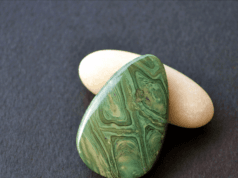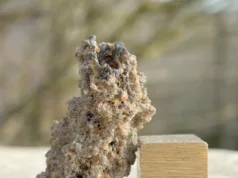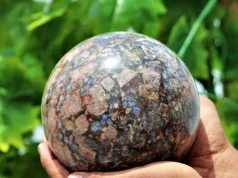Trachyte is a type of volcanic rock that falls within the category of extrusive igneous rocks. It is characterized by its unique composition and texture, which make it distinct from other volcanic rocks like basalt, andesite, and rhyolite. Trachyte gets its name from the Greek word “trachys,” which means rough, reflecting the rock’s typically rough texture.
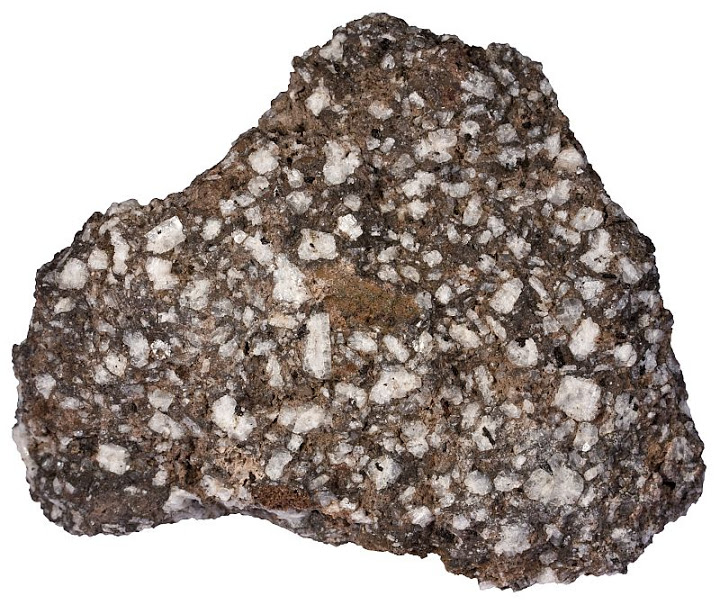
Composition: Trachyte is primarily composed of alkali feldspar minerals, especially sanidine or orthoclase, along with smaller amounts of other minerals like quartz, biotite, and hornblende. The dominance of alkali feldspar gives trachyte its distinctive pink, light gray, or white coloration.
Texture: Trachyte has a fine-grained to porphyritic texture, with the presence of phenocrysts (large mineral crystals) embedded within a groundmass of smaller crystals. The groundmass often appears fine-grained and may have a glassy appearance due to rapid cooling.
Formation: Trachyte is formed through volcanic processes when magma with a specific composition, rich in alkali feldspar and low in silica, rises to the surface and solidifies. The exact conditions under which trachyte forms can vary, but it often occurs in volcanic domes, lava flows, and pyroclastic deposits.
Properties: Trachyte is known for its relatively low density, making it lighter than other volcanic rocks like basalt. It also tends to be less dense than granite, which is another common felsic igneous rock.
Uses: Trachyte is not as widely used in construction or ornamentation as some other rocks like granite or marble. However, it has been used in the past for building materials, including in ancient architectural structures and sculptures. Its unique appearance makes it suitable for decorative purposes.
Geological Significance: The presence of trachyte in a region can provide insights into the geological history and the type of volcanic activity that occurred there. It is often associated with caldera-forming eruptions and is used by geologists to understand the volcanic history of an area.
Trachyte is associated with other lavas in volcanic regions and it have been formed by the crystallization and abstraction of iron, magnesium, and calcium minerals from a parent basaltic lava.
Volcanic Equivalent: Syenite
Group: Volcanic.
Colour: Variable but often light coloured, generally light coloured phenocrysts.
Texture: Usually porphyritic (can be trachytic), sometimes aphanitic.
Mineral Content: Orthoclase phenocrysts in a groundmass of orthoclase with minor plagioclase,biotite, hornblende, augite etc..
Silica (SiO 2) content – 60%-65%.
Contents
Trachytic Texture

Trachytic texture, also known as trachytic structure or trachytic fabric, is a specific type of texture found in certain volcanic rocks, particularly in trachyte, which is an extrusive igneous rock. This texture is characterized by a specific arrangement of mineral crystals and can be identified by several key features:
- Fine-Grained Groundmass: Trachytic rocks typically have a fine-grained groundmass, which means that the majority of the rock consists of small mineral crystals that are too small to be seen with the naked eye. This groundmass forms the background or matrix of the rock.
- Phenocrysts: One of the distinguishing features of trachytic texture is the presence of larger mineral crystals known as phenocrysts within the fine-grained groundmass. These phenocrysts are often well-formed and visible to the naked eye. In trachyte, the most common phenocrysts are alkali feldspar minerals, such as sanidine or orthoclase.
- Orientation and Alignment: The phenocrysts in trachytic texture are often oriented and aligned in a preferred direction. This alignment is a result of the flow or movement of the magma during the rock’s formation. It can give the rock a somewhat banded or foliated appearance, with the phenocrysts arranged in a preferred orientation within the fine-grained matrix.
- Porphyritic Texture: Trachytic rocks often exhibit a porphyritic texture, where the phenocrysts stand out as distinct, larger crystals within the finer-grained background. The contrast between the phenocrysts and the groundmass is a notable feature of this texture.
Trachytic texture is not unique to trachyte; it can also be found in other volcanic rocks of similar composition and formation conditions. The presence of phenocrysts and their orientation within the fine-grained matrix is a result of the cooling and crystallization of magma under specific conditions, often related to slower cooling and crystallization compared to some other volcanic rocks like basalt.
The orientation and alignment of the phenocrysts in trachytic texture can provide insights into the geological history and conditions of the volcanic eruption that produced the rock. The combination of fine-grained matrix and well-defined phenocrysts contributes to the distinctive appearance of trachytic rocks.
Types and Varieties of Trachyte

Trachyte is a relatively homogenous rock type in terms of its composition, consisting primarily of alkali feldspar minerals, with smaller amounts of other minerals like quartz, biotite, and hornblende. While it doesn’t exhibit the same wide variety of types and varieties as, for example, granite or basalt, it can still be classified into specific types based on geological and geographic factors. Some of these types and varieties of trachyte include:
- Sanidine Trachyte: Sanidine trachyte is characterized by the prevalence of sanidine, a type of alkali feldspar, in its composition. Sanidine is a high-temperature form of potassium feldspar and is often the dominant mineral in trachyte. This variety is named after its dominant mineral.
- Orthoclase Trachyte: Orthoclase is another common alkali feldspar found in trachyte. In orthoclase trachyte, orthoclase feldspar is the primary feldspar mineral, giving the rock its characteristic appearance. This variety is named after its dominant mineral.
- Porphyritic Trachyte: Porphyritic trachyte contains phenocrysts, which are relatively large crystals of minerals, embedded in a finer-grained groundmass. These phenocrysts can include sanidine or orthoclase feldspar, quartz, and other minerals. The porphyritic texture adds to the visual appeal of trachyte.
- Bluish Trachyte: In some cases, trachyte can have a bluish tint, which is often due to the presence of blue amphibole minerals like arfvedsonite or riebeckite. These blue amphiboles are less common but can give the rock a distinctive appearance.
- Rough Trachyte: The term “rough trachyte” is often used to describe the texture of this rock. Trachyte typically has a rough, slightly abrasive feel due to its fine-grained groundmass.
- Altered or Weathered Trachyte: Trachyte can undergo alteration due to weathering processes or the infiltration of fluids. This alteration can change the color, texture, and mineral composition of the rock, resulting in various altered forms.
- Geological Varieties: Trachyte deposits can vary depending on the geological settings in which they form. For instance, trachyte domes, which are conical volcanic features, may exhibit variations in mineral composition and texture.
It’s important to note that while these types and varieties of trachyte are recognized, they are typically based on the dominant minerals or geological context and may not represent completely distinct rock types. The specific characteristics of trachyte can vary widely from one location to another, and geologists often categorize them based on their distinguishing features.
Chemical Composition of Trachyte

The composition of trachyte is characterized by specific minerals and their relative proportions. Trachyte is classified as a felsic or intermediate volcanic rock, and its composition can vary somewhat from one geological location to another. However, the following minerals are typically found in trachyte, along with their approximate relative proportions:
- Alkali Feldspar (Sanidine or Orthoclase): Alkali feldspar is the dominant mineral in trachyte, making up a significant portion of its composition. Sanidine and orthoclase are the two most common varieties of alkali feldspar found in trachyte. They give trachyte its characteristic pink, light gray, or white color.
- Quartz: Trachyte may contain small amounts of quartz, which is a common mineral in many igneous rocks. The presence of quartz in trachyte is typically limited, as trachyte is not as silica-rich as rocks like granite.
- Biotite: Biotite is a mica mineral and can be found in trachyte in smaller quantities. It often appears as dark, flaky crystals and contributes to the rock’s overall mineral composition.
- Hornblende: Hornblende is another mineral that can be present in trachyte in varying amounts. It is a dark-colored amphibole mineral and is generally found in smaller proportions compared to alkali feldspar.
- Accessory Minerals: Trachyte may also contain other accessory minerals, such as pyroxenes, magnetite, apatite, and zircon. The presence and proportions of these minerals can vary depending on the specific geologic environment where the trachyte is formed.
Trachyte’s composition is characterized by its relatively low silica content compared to felsic rocks like granite. This lower silica content, along with the dominance of alkali feldspar, sets trachyte apart from other types of volcanic rocks. It results in a unique combination of minerals that give trachyte its distinctive appearance and properties.
Formation of Trachyte

The formation of trachyte is closely linked to specific geological processes and the composition of magma. Here’s an overview of how trachyte is formed and some common locations where it is found:
Formation of Trachyte:
- Magma Composition: Trachyte is formed from magma that is characterized by a specific chemical composition. This magma is typically rich in alkali feldspar minerals, such as sanidine or orthoclase, and relatively low in silica. This results in a felsic or intermediate composition, making trachyte different from other volcanic rocks.
- Magma Ascent: Trachyte magma forms deep within the Earth’s crust, and it rises toward the surface due to various geological processes. The exact mechanism of ascent can vary, but it often involves the movement of molten rock through fractures or conduits within the Earth’s crust.
- Pressure and Temperature Changes: As the magma ascends, it experiences changes in pressure and temperature. These changes can lead to crystallization of the minerals within the magma, including the growth of alkali feldspar crystals.
- Cooling and Solidification: Trachyte magma cools and solidifies relatively quickly after reaching the surface. This rapid cooling results in the fine-grained to porphyritic texture of trachyte, with phenocrysts (large crystals) embedded in a groundmass of smaller crystals.
Locations where Trachyte is Commonly Found: Trachyte can be found in various geological settings, and its presence is often associated with specific types of volcanic activity:
- Volcanic Domes: Trachyte is commonly found in the form of volcanic domes or lava domes. These are conical or dome-shaped volcanic features created by the slow extrusion of viscous trachyte lava. Examples of trachyte domes can be found in volcanic regions worldwide, including some in the United States, Italy, and New Zealand.
- Calderas: Trachyte can also be associated with calderas, which are large, collapsed volcanic craters. The remnants of trachyte eruptions can be found within or around calderas. For instance, the Taupo Volcanic Zone in New Zealand contains trachyte deposits associated with caldera-forming eruptions.
- Pyroclastic Deposits: Trachyte may occur as pyroclastic deposits, such as ashfall and pyroclastic flow deposits. These deposits can be found in regions where trachyte eruptions have produced explosive volcanic activity.
- Ancient Architecture: In some regions, trachyte has been quarried and used as a building material in ancient architecture. For example, some historical structures in Rome, Italy, were constructed using trachyte.
It’s important to note that the specific locations where trachyte is found can vary widely, and the presence of trachyte in a region provides valuable insights into its geological history and the types of volcanic activity that have occurred there.
Uses of Trachyte
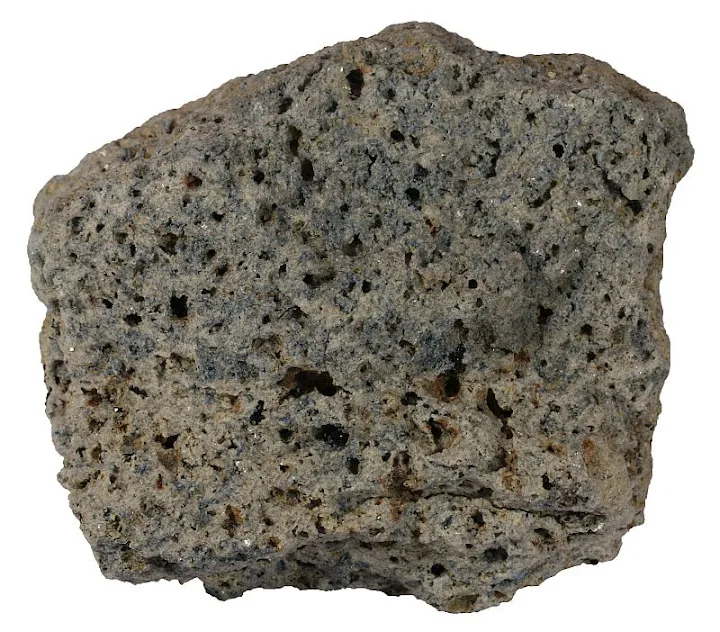
Trachyte, a volcanic rock with unique characteristics, has been used for various purposes throughout history. While it is not as widely utilized as some other types of stone, its distinctive appearance and properties make it suitable for specific applications. Here are some common uses of trachyte:
- Construction Material: Trachyte has been used as a construction material in the past. Its durability and resistance to weathering, along with its fine-grained texture, made it a suitable choice for building structures, such as walls, foundations, and architectural details. Historical buildings in regions with trachyte deposits have used this rock as a construction material.
- Decorative Stone: Trachyte’s unique appearance, which includes its pink, light gray, or white coloration, makes it a desirable choice for decorative purposes. It has been used in the creation of sculptures, monuments, and decorative stonework.
- Paving Stones: Trachyte can be cut into uniform, flat blocks and used as paving stones or cobblestones. Its durability and textured surface can make it suitable for walkways, patios, and streetscaping projects.
- Crushed Stone and Aggregates: Trachyte can be crushed and used as a component in the production of aggregates for use in concrete and road construction. It can add texture and durability to concrete mixes when used as an aggregate.
- Landscaping and Garden Design: Trachyte’s decorative properties make it a popular choice for landscaping and garden design. It can be used for features like garden walls, rockeries, and decorative elements in outdoor spaces.
- Kitchen Countertops and Tiles: In some cases, trachyte has been used as a material for kitchen countertops and tiles. Its resistance to heat and its unique appearance can make it a choice for those seeking a distinctive look in their kitchen.
- Geological and Educational Uses: Trachyte samples are often collected for educational and geological purposes. They are studied by geologists and earth science enthusiasts to understand volcanic processes and the history of a particular geological area.
- Historical Preservation: Trachyte has historical significance in regions where it has been used in architectural and decorative elements. Preservation efforts may involve the careful restoration or maintenance of trachyte structures and features.
It’s important to note that the utilization of trachyte can be regional and may depend on its availability in specific areas. Additionally, as architectural and construction preferences evolve, the use of trachyte may change over time, with some traditional uses being replaced by more modern materials.
Examples of Trachyte Landforms
Trachyte landforms are geological features and landscapes that are primarily composed of or influenced by trachyte, a type of volcanic rock. Trachyte landforms can take various shapes and forms depending on the geological processes that shaped them. Here are a few examples of trachyte landforms:
- Trachyte Domes: Trachyte domes are conical or dome-shaped volcanic landforms created by the slow extrusion of highly viscous trachyte lava. These domes can be found in volcanic regions and are typically characterized by their steep sides and the presence of trachyte rock. Examples of trachyte domes include Mount Meager in British Columbia, Canada, and the Cerro El Condor in Argentina.
- Trachyte Plateaus: Trachyte can contribute to the formation of elevated plateaus when large volumes of trachyte lava accumulate and solidify over time. These plateaus may have a flat or gently sloping top surface and are often surrounded by steep cliffs. An example of a trachyte plateau is the Atherton Tableland in Queensland, Australia.
- Trachyte Tuff Rings: Trachyte tuff rings are volcanic landforms created by explosive eruptions of trachyte magma. These eruptions produce a circular or horseshoe-shaped ring of volcanic material that can include trachyte, ash, and other volcanic debris. These formations can be found in volcanic fields and often have a central crater or depression. One example of a trachyte tuff ring is the Maungarei (Mount Wellington) in New Zealand.
- Trachyte Pyroclastic Deposits: Trachyte eruptions can produce pyroclastic deposits, including ashfall and pyroclastic flow deposits. These deposits are often found in volcanic regions where trachyte volcanic activity has been explosive. Pyroclastic deposits can cover large areas and influence the local topography.
- Trachyte Intrusions: Trachyte can also form intrusive landforms when it intrudes into existing rock formations, such as sedimentary rock. These intrusions can create distinctive geological features in the landscape, including dikes, sills, and laccoliths.
- Trachyte Caves and Underground Features: Trachyte, with its relatively high resistance to weathering, can contribute to the formation of caves and underground features when it is exposed to erosion and dissolution processes. Trachyte caves may contain unique mineral formations.
These are just a few examples of trachyte landforms, and the specific characteristics and appearance of these landforms can vary depending on the geological history of the region and the specific properties of the trachyte involved. Trachyte landforms are often of interest to geologists and can provide valuable insights into past volcanic activity and geological processes.
Comparison with Other Volcanic Rocks
Trachyte is a type of volcanic rock, and it can be compared and contrasted with other common volcanic rocks like basalt, andesite, and rhyolite based on various properties and characteristics. Here is a comparison of trachyte with these other volcanic rocks:
- Composition:
- Trachyte: Trachyte is a felsic to intermediate volcanic rock, meaning it has a relatively low silica content (typically around 60-65%) and is rich in alkali feldspar minerals, such as sanidine or orthoclase.
- Basalt: Basalt is a mafic volcanic rock with a low silica content (typically around 45-50%) and is primarily composed of plagioclase feldspar, pyroxenes, and olivine.
- Andesite: Andesite is an intermediate volcanic rock with a silica content intermediate between basalt and rhyolite (around 55-60%) and contains plagioclase feldspar, pyroxenes, and amphibole.
- Rhyolite: Rhyolite is a felsic volcanic rock with a high silica content (typically over 70%) and is composed primarily of quartz, alkali feldspar, and plagioclase feldspar.
- Color and Texture:
- Trachyte: Trachyte is often pink, light gray, or white in color and typically has a fine-grained to porphyritic texture with embedded phenocrysts.
- Basalt: Basalt is usually dark gray to black in color and has a fine-grained, aphanitic texture, lacking visible phenocrysts.
- Andesite: Andesite is typically gray to brown and exhibits a fine-grained to porphyritic texture with phenocrysts, often plagioclase feldspar.
- Rhyolite: Rhyolite is usually light gray to pink or reddish and has a fine-grained to glassy texture with minimal phenocrysts.
- Density and Weight:
- Trachyte: Trachyte is less dense and lighter in weight compared to basalt.
- Basalt: Basalt is denser and heavier due to its higher iron and magnesium content.
- Andesite: Andesite falls between trachyte and basalt in terms of density and weight.
- Rhyolite: Rhyolite is similar in density to trachyte due to its felsic composition.
- Eruption Style:
- Trachyte: Trachyte eruptions are generally less explosive than rhyolite but more explosive than basalt. They often produce lava domes.
- Basalt: Basaltic eruptions are typically non-explosive and produce low-viscosity lava flows.
- Andesite: Andesitic eruptions can vary but are often associated with stratovolcanoes and intermediate explosivity.
- Rhyolite: Rhyolitic eruptions tend to be highly explosive, producing volcanic ash clouds and pyroclastic flows.
- Geological Settings:
- Trachyte: Trachyte is commonly found in volcanic domes, calderas, and pyroclastic deposits.
- Basalt: Basalt is found in shield volcanoes, rift zones, and oceanic plate boundaries.
- Andesite: Andesite is often associated with subduction zones and stratovolcanoes.
- Rhyolite: Rhyolite is found in continental volcanic settings and calderas.
These comparisons highlight the differences in composition, appearance, eruption style, and geological settings of trachyte, basalt, andesite, and rhyolite, which are four distinct categories of volcanic rocks. Each of these rocks has its own unique characteristics and plays a role in our understanding of the Earth’s geological history.
References
Bonewitz, R. (2012). Rocks and minerals. 2nd ed. London: DK Publishing.
Wikipedia contributors. (2019, January 20). Trachyte. In Wikipedia, The Free Encyclopedia. Retrieved 00:54, April 11, 2019, from https://en.wikipedia.org/w/index.php?title=Trachyte&oldid=879352410


























